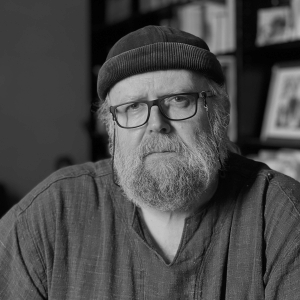Dominique Laugé
Dominique Laugé was born in La Rochelle in 1958 and studied literature at the University of Bordeaux. Between 1982 and 1984 he followed courses at the Brooks Institute of Photography in Santa Barbara, California, where he also studied the zone system under Bob Werling and Ansel Adams. He worked as a professional photographer in Milan from 1985 to 2005. Back to France, he produced images for exhibition and books, and created with his wife a center for photography in Gaillac, France, specialised in printing both traditional and digital photography.
During his career Dominique Laugé received many prizes, amongst which were the Epica International advertising prize for the Ciappi campaign (1990), the Art Directors Club Italian for several advertising campaigns (1991, 1993) the Kodak European Gold Award for Portrait Photography (1995, 1996), the Prix Mediastar for the IULM campaign (2005), and short listed for his book, Aubes et Crépuscules for the Fedrigoni best publication award with the Odyssée Editions. He exhibited in Paris, Milan, Rome, Hong Kong, Beijing, and Atlanta and published books amongst which are :
2024 « Aubes et crépuscules » Edition Odyssée Paris
2016 « Taklamakan » with Laurent Gayard, Johan and Levi Edition, Milan.
2010 « 365 Etincelles » with François Cassingena Trevedy; Editions de l’œuvre.
2009 « Bestiary » Editions Johan & Levi, Milan
2006 « L’occhio Incantato » Editions Johan & Levi, Milan
2002 « Paysages et Bestiaire » Editions Mazzotta, Milan
Laugé is highly regarded for his mastery of fine art digital printmaking, particularly his work with advanced monochrome processes. Among his signature techniques is Piezography®, which uses carbon-based pigments to produce archival black and white prints with exceptional tonal range. He also works with digital negatives to create platinum-palladium contact prints, combining traditional processes with modern technology. These approaches give his work a distinctive quality of depth, detail, and permanence.
His 2024 exhibition La lumière du sombre in Gaillac presented large-scale works, printed in formats up to 80×120 cm using heavyweight archival papers such as Arches Aquarelle and Velin BFK Rives. The images, created with Piezography inks, conveyed subtle gradations of shadow and light, reflecting his fascination with liminal spaces. Alongside exhibitions, he conducts workshops on digital negatives, platinum-palladium printing, and Piezography, sharing his expertise with both emerging and established photographers. His focus on the materiality of prints underscores his belief that photography is not only about image capture but also about the craft of rendering the photograph as a physical, enduring object.
Today, Laugé divides his time between Paris, Gaillac, and Milan. His work continues to be exhibited widely in Europe and beyond, while his printmaking knowledge is sought after for both artistic and educational projects. Through his personal practice, teaching, and curatorial activities, he remains deeply engaged in advancing photography as an art form. His dual focus on visual storytelling and fine printmaking ensures that his photographs are experienced not only as images but as objects of lasting artistic and material value.
As a photographer that had the privilege of studying under Bob Werling and Ansel Adams, I always have always been interested in the prints and their different techniques. I acquired the Zone system in 1983, experimented and improved my skill for 20 years in the darkroom until the best material for silver halide photography started to disappear. I then started to practise digital photography and in 1995 made my first digital prints from scanned transparencies. In the start of the new century I got my first full frame digital camera and an Epson 24 inches printer. Since then I have worked on digital printing in color and black and white. In 2018 I reopened my darkroom since I could produce excellent digital negatives for platinum-palladium printing. I am following closely all improvement in the printing industry in the pursuit in excellence in the field.
